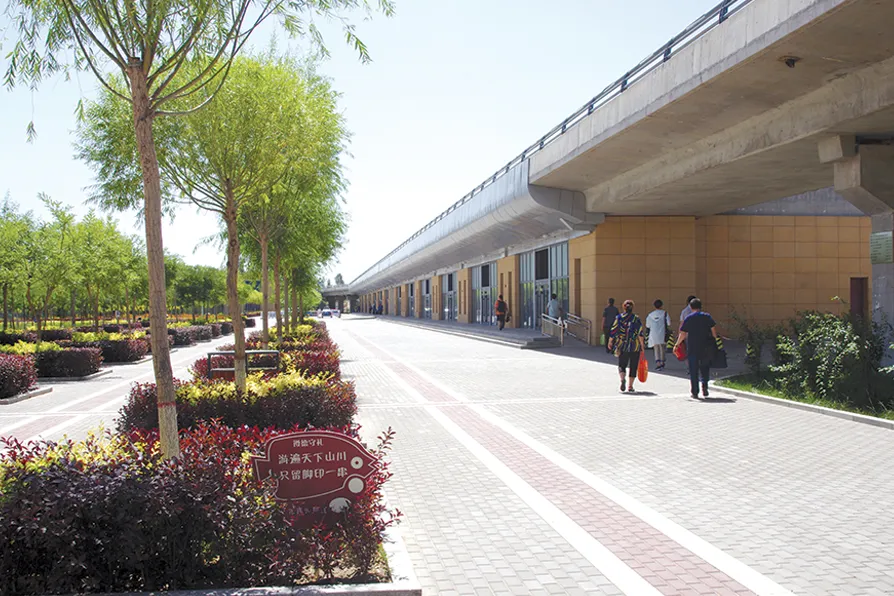RAMZY BAROUD offers six reasons why Netanyahu is prolonging conflict in the Middle East
PAWEL WARGAN juxtaposes the thriving industrial centre Jiayuguan in China, with the prevailing images of decaying East European great industrial cities

 Jiayuguan railway station featuring a taxi stand and local public bus transport, 2017 / Pic: Livewireshock/CC
Jiayuguan railway station featuring a taxi stand and local public bus transport, 2017 / Pic: Livewireshock/CC
THOSE of us who were born on the ruins of the socialist Eastern Bloc know how purpose-built, industrial “monotowns” are meant to look.
Rusting steel mills, cracked and potholed roads, weathered sheets of corrugated metal strewn about. Thick smog and poisoned soil. Drunks passed out on the train platform. Emaciated stray dogs. A lone child skipping down the muddy path of a panel-block neighbourhood silenced by demographic blight.
In their commodified form, packaged for mass consumption in computer games and television shows, these images of post-socialist decay serve a purpose. They beat down the idea that socialism can produce anything but misery. And they have become so firmly embedded in the popular imagination that, for many, it is difficult to believe otherwise.
Of course, many of these cities were conceived as the opposites of the dark imaginaries later built around them.
To this day, we can find shadows of the ideal in Poland’s Nowa Huta, the sprawling Krakow neighbourhood built around the Vladimir Lenin Steelworks; Russia’s Magnitogorsk, built around its eponymous Iron and Steel Works; or Germany’s Eisenhuttenstadt, established by the socialist German Democratic Republic around a major steel mill combine.
Each aspired to be a model city — a template for the dignified life that communism envisioned for all working people. Each had green parks, good housing, abundant public services, and wide roads whose grandeur and neat symmetries recalled the genteel boulevards of Haussmannian Paris.
But capitalist restoration shattered their ambitions. Vibrant industrial cities saw their mills and factories chopped and diced and sold off at bargain prices. Economies underpinned by planned industrialisation were transformed overnight into sites of desperate labour and cheap resources, where value was siphoned upwards, to the emergent national oligarchies, then outwards to Wall Street or the City of London.
With that shift came an explosion in unemployment and an assault on society’s support systems: housing, healthcare, leisure, education, catering, and so on. The model cities became grayer. The metal rusted and the plaster began to flake off the walls. People left; many died. Then, these hollowed spaces became captive to imaginaries of failure established to keep a defeated people from ever seeking their sovereignty again.
How might these cities look today had the process of socialist construction continued uninterrupted? I found one possible answer in Jiayuguan, a remote desert city in China’s Gansu Province built from the ground up around a steel plant.
In 1955, under a decade after the Chinese Revolution, prospectors from Team 645 of the North-west Geological Bureau discovered major iron ore deposits in the Hexi Corridor of the snow-capped Qilian Mountains. Over 1,500 people would be called to the expedition, and 11 lost their lives.
With the discovery of iron, a vision emerged that would transform this barren patch of desert — once a strategic outpost on the ancient Silk Road, the western terminus of the Great Wall, and the threshold of the Gobi Desert — into a cornerstone of regional development.
The Jiuquan Iron and Steel Corporation (JISCO) was founded in 1958 as part of revolutionary China’s ambitious drive to establish the basis of a modern, industrialised economy.
It was a gruelling effort. At the heels of a century of humiliation, protracted civil war, and long struggle against Japanese occupation, China lacked basic technologies and know-how. Workers who came to the region dug the earth with their hands, trudged through waist-high mud, and carried heavy equipment on their backs. They faced the desert’s biting cold and punishing heat. It took the nascent industry more than a decade to break even.
But development continued, and the steel plant soon began reshaping the political geography of the region. The administrative boundaries were redrawn to create Jiayuguan City, carved from parts of surrounding counties and placed under provincial jurisdiction.
Now, where once there was desert stands China’s fourteenth-largest steel producer. It has an annual capacity of over 11 million tons of crude steel — double the total steel-making capacity of Britain.
JISCO has manufactured everything from the steel Apple logo on the back of the iPhone to the lattice shell and steel trussed columns of the “Bird’s Nest” National Stadium in Beijing.
The state enterprise has expanded its activities far beyond metals, to agricultural products and industrial manufacturing equipment, packaging and logistics, housing and healthcare, education and even wine.
The largest wine cellar in Asia is found at the Zixuan Winery near the Jiayuguan steel mills. The winery was the first in China to receive both national and international organic certifications, winning several awards in the process. (Having first tried Chinese wine as recently as a decade ago — and knowing that wines are notoriously slow to improve given the frequency of harvests — I was taken aback by the delicious, plummy and well-rounded merlot made here.)
JISCO also manages the city’s power grid. Its Smart Grid and Localised New Energy Consumption Demonstration Project, powered almost entirely by artificial intelligence, automatically distributes energy, optimising for consumption patterns in real-time.
Despite JISCO’s expanded production capacity and Jiayuguan’s rising living standards, energy consumption has decreased thanks to investments in efficiency — a decoupling of growth from energy use that many experts in the West say is impossible.
JISCO’s industrial waste is collected and used to make the tiles that cover the city’s broad pavements and public squares.
Alongside the industry, Jiayuguan City continued to develop. In many ways, the process mirrored efforts to build socialist industrial towns across the Eastern Bloc. But there is a crucial difference: Jiayuguan’s development was never interrupted, never subjected to the shock therapy of capitalist restoration.
Today, Jiayuguan is so unlike how we might expect a purpose-built industrial city to look. It is clean. Its green boulevards are lined with trees and neatly-trimmed hedges. Broad cycling lanes line the city’s well-paved roads, and new apartment blocks — buildings that might well be considered luxury housing in the West — rise against the backdrop of mountain peaks to house the city’s growing worker population. Trees cover some 40 per cent of this desert land and many of the city’s scenic parks are built around large, cerulean lakes.
On my last day in Jiayuguan, I told a local teacher that it was moving, coming from a part of the world that had lost its socialist path, to see a place where the story of the model city continues to be written.
Jiayuguan offered proof that the images of decay and despair that many have come to associate with industrial cities in Eastern Europe were not products of their socialist past, but symptoms of their capitalist present.
“China not only learned from the experiences of Eastern Europe,” he told me. “China saved socialism.” I asked how he felt about the changes his city had seen in the past few decades. His eyes smiled and he responded with seven words that we who call ourselves communists desperately wish to hear from all humanity: “I am satisfied, and I am proud.”

STEPHEN BELL reports from a delegation that traced the steps of China’s socialist revolution from its first modest meetings to the Red Army’s epic 9,000km battle to create the modern nation that today defies every capitalist assumption

One of the major criticisms of China’s breakneck development in recent decades has been the impact on nature — returning after 15 years away, BEN CHACKO assessed whether the government’s recent turn to environmentalism has yielded results

Activists from across the world gathered in China for an educational exchange where they witnessed the progress the country has made in building an ecological society and discussed the path to peaceful international relations, reports CALLUM NORRIS











